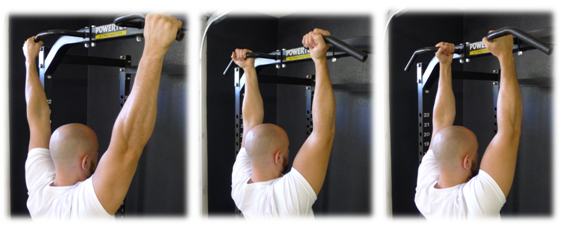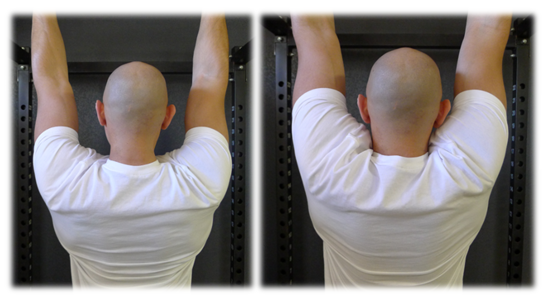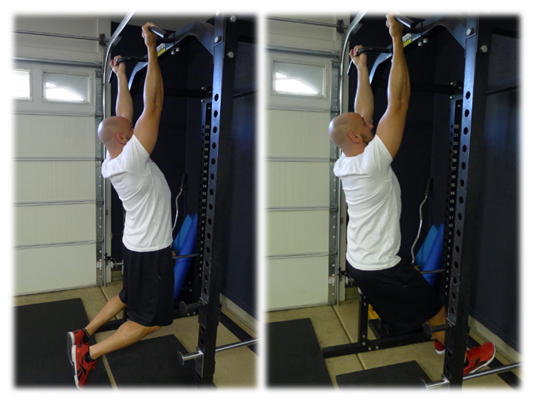50 Pullups Programme
50 Pullups Programme is a training programme which will help you develop your strenght and physique.
Most people can do less than 10 pullups and very few can do more than 15. With our programme you will be able to improve your results. Our training programme is designed to help you reach at least 30 pullups.
30 or 50?
The programme is written up to 50 pullups. It is a lot and it is extremely difficult do reach.
We created such plan so that anyone can aim at perfection.
To be honest though, when you reach 30 pullups, it will already be a really impressive achievement. You will have developed your strength and physique substantially. 30 pullups is absolutely enough to maintain healthy, developed muscles and you don't need to do more than that.
However, if you want to aim higher, we have 50 pullups for you
Before you start
You can read about it all here, on our site.
Good luck!
==========
Rules of 50 Pullups Programme
The rules of 50 Pullups Programme are simple:
==========
The Test
Pullup test is an inseparable part of the programme. The test ensures that you train in the cycle matching your fitness level.
Before you start the test make sure that there aren't any medical reasons for you to not train. If you have any doubts consult your doctor.
The test
This test is really simple. You just do as many pullups as you can. It's just as easy.
One thing you shout remember is to do the pullups correctly. Don't cheat yourself. The test will help you choose the apporpriate training cycle. If you choose incorrectly, the results won't be as good as they could.
If you do the test correctly you will be absolutely exhausted. You will not able to do another pullup at all. But be careful – overworking your body may lead to an injury and can interrupt your training, do do not exaggerate either.
Remember to rest before and after the test for at least 2 days. Don't do the test immediately after finishing a cycle and don't jump to another cycle straight after the test either. Too intensite trainig slows down the growth of muscles and in some situations can completely stop it. Remember to give your muscles rest after every session. Remember to warm up – stretching, swings, etc. will be really helpful.
Test results
During the test you count only these pullups during which you managed to raise your chin above the pullup bar. You also don't count the last pullup which you didn't do completely.
This test will help you decide which cycle to choose.
After each training cycle, the amount of pullups you can do will rise and you will change cycles to more and more advanced ones. You will achieve 30 or even 50 pullups in no time.
>>>50 Pullups | Ultimate pullups training<<<
50 Pullups Programme is a training programme which will help you develop your strenght and physique.
Most people can do less than 10 pullups and very few can do more than 15. With our programme you will be able to improve your results. Our training programme is designed to help you reach at least 30 pullups.
30 or 50?
The programme is written up to 50 pullups. It is a lot and it is extremely difficult do reach.
We created such plan so that anyone can aim at perfection.
To be honest though, when you reach 30 pullups, it will already be a really impressive achievement. You will have developed your strength and physique substantially. 30 pullups is absolutely enough to maintain healthy, developed muscles and you don't need to do more than that.
However, if you want to aim higher, we have 50 pullups for you

Before you start
- familiarize yourself with rules of the programme,
- learn how to warm up before the training,
- learn how a correct pullup looks like.
You can read about it all here, on our site.
Good luck!
==========
Rules of 50 Pullups Programme
The rules of 50 Pullups Programme are simple:
- Do the test. The result of the test will help you choose a training cycle suitable for your level of fitness.
- Choose a training cycle based on your test results. For example, if you've done 7 pullups, you start our programme from the 6-8 cycle. If you've done 12, you start from 12-15 cycle, and so on.
- Carry on with the training using the instructions from the given cycle. Remember to rest between training sessions for at least one day, and after 3 sessions for at least 2 days. Muscles don't like being overworked and if you exaggerate, your power will start to drop insead of rising. Some people will notice that longer rests between training days give them even better results. Remember also that if you're older, you need more time to regenerate.
- If during a cycle you weren't able to do all sets of pullups for a given day, don't worry. Rest for 2 or 3 days and then try again. Every time you do that, your strenght and fitness will rise and eventually you will complete the 'day" and move to the next.
- After finishing a cycle rest for at least 2 days before you do another test.
- After few days of rest do the test. Remember to warm up before the test and rest for at least 2 afterwards. The test will tell you which cycle to do next. It's not worth cheating during the test. It's better to repeat a cycle than start the next one if you aren't ready yet.
- After a 2 day break start your next training cycle.
- Follow the above instructions until you reach the last cycle (more than 40 pullups). When you reach the last cycle, you will be in a very good shape and you will be able to try to do 50 pullups. But remember – 30 is good enough to keep you fit and well built.
- After finishing the last training cycle take a break, relax for a couple of days and then do the test again. This time there's a big chance that you will reach 50 pullups. If not, don't worry. Do the last cycle again, and repeat again. With every repetition your strength and endurance will get higher and finally you will do it - you will do 50 pullups.
==========
The Test
Pullup test is an inseparable part of the programme. The test ensures that you train in the cycle matching your fitness level.
- You absolutely have to do the test before you start the programme, to see which cycle you should start with.
- You will have to repeat the test after every training cycle to see if you cam move to the next cycle or repeat the current one or maybe jump a few cycles up.
Before you start the test make sure that there aren't any medical reasons for you to not train. If you have any doubts consult your doctor.
The test
This test is really simple. You just do as many pullups as you can. It's just as easy.
One thing you shout remember is to do the pullups correctly. Don't cheat yourself. The test will help you choose the apporpriate training cycle. If you choose incorrectly, the results won't be as good as they could.
If you do the test correctly you will be absolutely exhausted. You will not able to do another pullup at all. But be careful – overworking your body may lead to an injury and can interrupt your training, do do not exaggerate either.
Remember to rest before and after the test for at least 2 days. Don't do the test immediately after finishing a cycle and don't jump to another cycle straight after the test either. Too intensite trainig slows down the growth of muscles and in some situations can completely stop it. Remember to give your muscles rest after every session. Remember to warm up – stretching, swings, etc. will be really helpful.
Test results
During the test you count only these pullups during which you managed to raise your chin above the pullup bar. You also don't count the last pullup which you didn't do completely.
This test will help you decide which cycle to choose.
After each training cycle, the amount of pullups you can do will rise and you will change cycles to more and more advanced ones. You will achieve 30 or even 50 pullups in no time.
>>>50 Pullups | Ultimate pullups training<<<







Comment